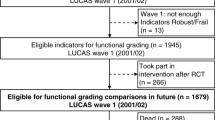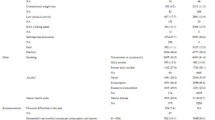Abstract
Background
Population aging is occurring worldwide. As a result, frailty and disability are in the full interest of practice, policy, and science. An increase in healthcare utilization is an adverse outcome of frailty and disability.
Objective
The aim of the present study was the prediction of six indicators of healthcare utilization by frailty and disability measures. The six indicators of healthcare utilization of interest were: use of informal care, number of visits to a general practitioner, hospital admission, receiving nursing care, receiving personal care, and contacts with (health)care professionals.
Methods
We used a sample of 484 people that was randomly drawn from the municipality of Roosendaal (the Netherlands), a municipality with 78,000 inhabitants. A subset of people who completed the Tilburg Frailty Indicator (TFI) at baseline and the Groningen Activity Restriction Scale (GARS) questionnaires was used with a nine-year followup. We used generalized estimation equations (GEE) to predict the six indicators with the frailty measures (physical, psychological, and social scores) and disability measures (ADL and IADL scores). We also performed GEE analyses adjusted for age, gender, and multimorbidity from part A of the TFI at baseline.
Results
The significant predictors were different for each indicator. However, the physical frailty score, the ADL score, and the IADL score often emerged as significant predictors. These three variables predicted several indicators of healthcare utilization: use of informal care, number of visits to a general practitioner, hospital admission, receiving nursing care, receiving personal care, and contacts with (health)care professionals. The social score was found to be significant for the indicator use of disciplines.
Conclusions
In conclusion, our study showed that in particular physical frailty, and ADL and IADL disability predicted healthcare utilization in community-dwelling people aged 75 years or older. It is important that care and welfare professionals pay attention to physical frailty and both ADL and IADL disability aiming to diminish frailty and disability and preventing intensive healthcare utilization and related costs. Future research will have to focus on more representative Dutch municipalities in order to get a more reliable and accurate picture of the disciplines used by people with frailty and disability.
Similar content being viewed by others
References
World Population Prospects 2022: Summary of Results. United Nations Department of Economic and Social Affairs, P. D.; 2022. Available from: https://www.un.org/development/desa/pd/sites/www.un.org.development.desa.pd/files/wpp2022summaryofresults.pdf.
Carmona-Torres JM, Rodriguez-Borrego MA, Laredo-Aguilera JA, Lopez-Soto PJ, Santacruz-Salas E, Cobo-Cuenca AI. Disability for basic and instrumental activities of daily living in older individuals. Plos one. 2019;14(7):e0220157.
Collard RM, Boter H, Schoevers RA, Oude Voshaar RC. Prevalence of frailty in community-dwelling older persons: a systematic review. Journal of the american geriatrics society. 2012;60(8):1487–1492.
Tas U, Verhagen AP, Bierma-Zeinstra SM, Hofman A, Odding E, Pols HA, et al. Incidence and risk factors of disability in the elderly: the Rotterdam Study. Preventive medicine. 2007;44(3):272–278.
Den Ouden ME, Schuurmans MJ, Mueller-Schotte S, Brand JS, Van Der Schouw YT. Domains contributing to disability in activities of daily living. Journal of the American Medical Directors Association. 2013;14(1):18–24.
Gobbens RJ. Associations of ADL and IADL disability with physical and mental dimensions of quality of life in people aged 75 years and older. PeerJ. 2018;6:e5425.
Fried LP, Ferrucci L, Darer J, Williamson JD, Anderson G. Untangling the concepts of disability, frailty, and comorbidity: implications for improved targeting and care. The Journals of Gerontology Series A: Biological Sciences and Medical Sciences. 2004;59(3):M255–M263.
Han L, Clegg A, Doran T, Fraser L. The impact of frailty on healthcare resource use: a longitudinal analysis using the Clinical Practice Research Datalink in England. Age and ageing. 2019;48(5):665–671.
Gobbens RJ, Van Der Ploeg T. The prediction of mortality by disability among Dutch community-dwelling older people. Clinical interventions in aging. 2020; p. 1897–1906.
Majer IM, Nusselder WJ, Mackenbach JP, Klijs B, Van Baal PH. Mortality risk associated with disability: a population-based record linkage study. American Journal of Public Health. 2011;101(12):e9–e15.
Vermeiren S, Vella-Azzopardi R, Beckwee D, Habbig AK, Scafoglieri A, Jansen B, et al. Frailty and the prediction of negative health outcomes: a meta-analysis. Journal of the American medical directors association. 2016;17(12):1163–e1.
Xue QL, Bandeen-Roche K, Tian J, Kasper JD, Fried LP. Progression of Physical Frailty and the Risk of All-Cause Mortality: Is There a Point of No Return? Journal of the American Geriatrics Society. 2021;69(4):908–915.
Gobbens RJ, Luijkx KG, Wijnen-Sponselee MT, Schols JM. Toward a conceptual definition of frail community dwelling older people. Nursing outlook. 2010;58(2):76–86.
Kojima G. Frailty as a predictor of disabilities among community-dwelling older people: a systematic review and meta-analysis. Disability and rehabilitation. 2017;39(19):1897–1908.
Vermeulen J, Spreeuwenberg MD, Daniels R, Neyens JC, Van Rossum E, De Witte LP. Does a falling level of activity predict disability development in community-dwelling elderly people? Clinical rehabilitation. 2013;27(6):546–554.
Fried LP, Tangen CM, Walston J, Newman AB, Hirsch C, Gottdiener J, et al. Frailty in older adults: evidence for a phenotype. The Journals of Gerontology Series A: Biological Sciences and Medical Sciences. 2001;56(3):M146–M157.
Gobbens RJ, Van Assen MA, Luijkx KG, Wijnen-Sponselee MT, Schols JM. The Tilburg frailty indicator: psy- chometric properties. Journal of the American Medical Directors Association. 2010;11(5):344–355.
Mitnitski AB, Graham JE, Mogilner AJ, Rockwood K. Frailty, fitness and late-life mortality in relation to chrono- logical and biological age. BMC geriatrics. 2002;2(1):1–8.
Chang SF, Lin HC, Cheng CL. The relationship of frailty and hospitalization among older people: evidence from a meta-analysis. Journal of Nursing Scholarship. 2018;50(4):383–391.
Kojima G. Frailty as a predictor of hospitalisation among community-dwelling older people: a systematic review and meta-analysis. J Epidemiol Community Health. 2016;70(7):722–729.
Kojima G. Frailty as a predictor of nursing home placement among community-dwelling older adults: a systematic review and meta-analysis. Journal of geriatric physical therapy. 2018;41(1):42–48.
Park JM. Disability and health service utilization among old Koreans. Health. 2014;2014.
DeSA UN. World population prospects: The 2015 revision, findings and advance tables. Working PaperNo; 2015.
Van Campen C. Frail older persons in the Netherlands. Netherlands Institute for Social Research; 2011.
Gobbens RJ, Van Assen MA, Luijkx KG, Schols JM. The predictive validity of the Tilburg Frailty Indicator: disability, health care utilization, and quality of life in a population at risk. The Gerontologist. 2012;52(5):619–631.
Gobbens RJ, Van Assen MA. The prediction of quality of life by physical, psychological and social components of frailty in community-dwelling older people. Quality of Life Research. 2014;23(8):2289–2300.
Van Der Ploeg T, Gobbens RJ, Salem BE. Bayesian techniques in predicting frailty among community-dwelling older adults in the Netherlands. Archives of gerontology and geriatrics. 2023;105:104836.
Kempen GI, Miedema I, Ormel J, Molenaar W. The assessment of disability with the Groningen Activity Restriction Scale. Conceptual framework and psychometric properties. Social science & medicine. 1996;43(11):1601–1610.
Suurmeijer T, Doeglas DM, Moum T, Briançon S, Krol B, Sanderman R, et al. The Groningen Activity Restric- tion Scale for measuring disability: its utility in international comparisons. American Journal of Public Health. 1994;84(8):1270–1273.
Hardin JW. Generalized estimating equations (GEE). Encyclopedia of statistics in behavioral science. 2005;.
Twisk JW. Applied longitudinal data analysis for epidemiology: a practical guide. Cambridge University Press; 2013.
R Core Team. R: A Language and Environment for Statistical Computing. Vienna, Austria; 2019. Available from:https://www.R-project.org/.
Kringos DS, Boerma WG, Hutchinson A, Saltman RB, Organization WH, et al. Building primary care in a changing Europe. World Health Organization. Regional Office for Europe; 2015.
Bijnsdorp FM, Pasman HRW, Francke AL, Evans N, Peeters CF, Broese van Groenou MI. Who provides care in the last year of life? A description of care networks of community-dwelling older adults in the Netherlands. BMC palliative care. 2019;18(1):1–11.
Ensrud KE, Ewing SK, Taylor BC, Fink HA, Cawthon PM, Stone KL, et al. Comparison of 2 frailty indexes for prediction of falls, disability, fractures, and death in older women. Archives of internal medicine. 2008;168(4):382–389.
Hábert R, Bravo G, Korner-Bitensky N, Voyer L. Predictive validity of a postal questionnaire for screening community-dwelling elderly individuals at risk of functional decline. Age and ageing. 1996;25(2):159–167.
Santiago LM, Gobbens RJ, Van Assen MA, Carmo CN, Ferreira DB, Mattos IE. Predictive validity of the Brazilian version of the Tilburg Frailty Indicator for adverse health outcomes in older adults. Archives of gerontology and geriatrics. 2018;76:114–119.
Hardy SE, Dubin JA, Holford TR, Gill TM. Transitions between states of disability and independence among older persons. American journal of epidemiology. 2005;161(6):575–584.
Wong CH, Weiss D, Sourial N, Karunananthan S, Quail JM, Wolfson C, et al. Frailty and its association with disability and comorbidity in a community-dwelling sample of seniors in Montreal: a cross-sectional study. Aging clinical and experimental research. 2010;22:54–62.
Bravell ME, Zarit SH, Johansson B. Self-reported activities of daily living and performance-based functional ability: a study of congruence among the oldest old. European journal of ageing. 2011;8:199–209.
Op Het Veld LP, De Vet HC, Van Rossum E, Kempen GI, Van Kuijk SM, Beurskens AJ. Substitution of Frieds performance-based physical frailty criteria with self-report questions. Archives of gerontology and geriatrics. 2018;75:91–95.
Gobbens RJ, Van Assen MA, Augustijn H, Goumans M, Van Der Ploeg T. Prediction of mortality by the Tilburg Frailty Indicator (TFI). Journal of the American Medical Directors Association. 2021;22(3):607–e1.
Van der Ploeg T, Gobbens RJ. Disability transitions in Dutch community-dwelling older people aged 75 years or older. Archives of Gerontology and Geriatrics. 2024;116:105165.
Van Der Ploeg T, Gobbens R, et al. A Comparison of Different Modeling Techniques in Predicting Mortality With the Tilburg Frailty Indicator: Longitudinal Study. JMIR medical informatics. 2022;10(3):e31480.
Gobbens RJ, Van Der Ploeg T. The Development of Multidimensional Frailty Over Seven Years A longitudinal study among Dutch community-dwelling older people using the Tilburg Frailty Indicator. Archives of Gerontology and Geriatrics. 2021;95:104393.
Gobbens RJ, Van Der Ploeg T. The prediction of mortality by quality of life assessed with the WHOQOL-BREF: A longitudinal analysis at the domain and item levels using a seven-year follow-up period. Quality of Life Research. 2021;30(7):1951–1962.
Acknowledgements
We would like to thank the municipality of Roosendaal for making their data available.
Author information
Authors and Affiliations
Corresponding author
Ethics declarations
Conflicts of interest: The authors stated that there were no conflicts of interest.
Ethical standards: All procedures performed in studies involving human participants followed the ethical standards of the institute or national research committee and with the 1964 Helsinki declaration and its later amendments or comparable ethical standards. For the present study, medical ethics approval was not necessary because treatments or interventions were not offered or withheld from respondents. Moreover, the integrity of respondents was not encroached upon because of participating in this study, which is the main criterion in medical-ethical procedures in the Netherlands. Informed consent related to detailing the study and maintaining confidentiality was observed.
Electronic Supplementary Material
Rights and permissions
About this article
Cite this article
van der Ploeg, T., Gobbens, R.J.J. The Prediction of Healthcare Utilization by Frailty and Disability among Dutch Community-Dwelling People Aged 75 Years or Older. J Frailty Aging (2024). https://doi.org/10.14283/jfa.2024.14
Received:
Accepted:
Published:
DOI: https://doi.org/10.14283/jfa.2024.14




